
Original Link: https://www.anandtech.com/show/2238
Introduction
We recently reviewed the Intel P35 chipset in depth and found it to be a worthy successor to the P965 and competitor to the Intel 975X and NVIDIA 680i LT. We also provided a variety of information about the chipset and delved head first into some preliminary performance results. However, due to time constraints after receiving retail kits a couple of days before the chipset introduction, there were a few performance results that we did not include. We will go over storage, networking, and audio functionality in detail in our P35 roundup. Areas such as overclocking, memory performance, and features like Intel's Turbo Memory (Robson on Desktop) will be handled in separate articles over the coming weeks.Today's article will provide a quick performance peek at two areas that we received feedback on after the P35 article went live. We were in the process of testing these features, but didn't want to hold up our initial article several more days to give us time to complete testing. We received a new BIOS (0411) from ASUS for their P5K3 Deluxe motherboard that implements 1T command rate timings and allows us to run our current DDR3 memory from Corsair at slightly lower timings and voltages. We will present a few gaming benchmarks with this new BIOS and improved standard memory timings today. We are still testing the 1T functionality across several different DDR3 modules and will provide those results in the future.
The second part of our article will provide some initial CrossFire results with the ASUS P5K3 DDR3 platform. Our P35 DDR2 versus 975X preview performance numbers are available in this article for reference. We wanted to present additional performance numbers with the latest ATI HD 2900XT beta drivers but after experiencing numerous issues in Vista with OpenGL games and image quality problems in other titles we decided it would be best to wait on the final release drivers.
AMD has assured us the problems we experienced will be fixed in the final release driver code. The 7.5 Catalyst are now due at the end of May and we look forward to them. You might be wondering what the results were with games when the beta drivers worked correctly. We noticed on average a 2% increase in most games under Vista with slightly better performance improvements at lower resolutions. 3DMark scores improved up to 9% in some instances but we still noticed lower CrossFire scores in 3DMark2001 than single card scores. Overall, image quality was excellent and in games that have a lot of explosions and smoke we noticed clearer/sharper images than with our 8800GTS in side by side comparisons. Until we test the final release drivers our opinions are nothing more than subjective information.
Test Setup
| Standard Test Bed CrossFire / Vista Ultimate 64-Bit Test Configuration |
|
| Processor | Intel Core 2 Duo QX6700 (2.66GHz, 8MB Unified Cache) |
| RAM | OCZ Reaper PC2-9200 (4x1GB) 3-4-3-8 975X, 4-4-4-10 P35, P965, 680i Corsair DDR3 CM3X1024-1333C9DHX (4x1GB) 9-9-9-24 |
| Hard Drive | Western Digital 150GB 10,000RPM SATA 16MB Buffer |
| System Platform Drivers | Intel - 8.3.0.1013 |
| Video Cards | 2 x MSI HD2900XT |
| Video Drivers | ATI 8.37.4.3 (HD2900XT Release Drivers) ATI 8.38 Beta |
| CPU Cooling | Tuniq 120 |
| Power Supply | OCZ ProXStream 1000W |
| Optical Drives | Plextor PX-760A, Plextor PX-B900A |
| Case | Cooler Master CM Stacker 830 |
| Motherboards | Intel D975XBX2 (Intel 975X) - BIOS 2692 ASUS P5K Deluxe (Intel P35) - BIOS 0304 ASUS P5K3 Deluxe (Intel P35) - BIOS 0011 MSI P35 Platinum (Intel P35) - BIOS 7345P01 Gigabyte P35-DQ6 (Intel P35) - BIOS F4 DFI Infinity P965 (Intel P965) - BIOS 424 EVGA 680i LT SLI (NVIDIA 680i LT) - BIOS P04 |
| Operating System | Windows Vista Ultimate 64-Bit |
Test conditions were maintained the same, as much as possible, over the platforms tested. Our single GPU game tests were run at settings of 1280x1024 HQ to ensure our GPU was not a bottleneck during testing. Our limited CrossFire results were run at a resolution of 1920x1200 4xAA with 8xAF enabled where possible.
All results are reported in our charts and color-coded for easier identification of results. We utilize new drive images on each board in order to minimize any potential driver conflicts. Our 3DMark results are generated utilizing the standard benchmark resolution for each program. We run each benchmark five times, throw out the two low and high scores, and report the remaining score. All results are run at stock speeds for this article although we will provide overclocked results shortly.
Our choice of software applications to test is based on programs that enjoy widespread use and produce repeatable and consistent results during testing. Microsoft Vista has thrown a monkey wrench into testing as the aggressive nature of the operating system to constantly optimize application loading and retrieval from memory or the storage system presents some interesting obstacles. This along with the lack of driver maturity will continue to present problems in the near future with benchmark selections. Our normal process was to change our power settings to performance, delete the contents of the prefetch folder, and then reboot after each benchmark run. This is a lengthy process to be sure, but it results in consistency over the course of benchmark testing. All applications were run with administer privileges.
The test results today are preliminary and are meant to provide a first look at potential performance improvements with an improved BIOS, slightly lower standard memory timings, and CrossFire results with DDR3. We are utilizing initial DDR3-1066 and DDR3-1333 memory modules from Corsair. Our original P35 chipset article had memory settings set at 8-7-7-16 for DDR3-1066 and 9-9-9-24 with DDR3-1333.
Our test results are with the same memory modules, only now operating at 6-6-6-18 DDR3-1066 and 8-8-7-18 DDR3-1333 at stock voltages. Our current Corsair memory was not developed as true low latency DDR3; instead the ICs utilized offer reasonable latencies with significant headroom for overclocking. The tradeoff on improving the standard memory timings (DDR3-1066, 8-7-7-16 to 6-6-6-18) was relaxing the sub-timings and disabling the Transaction Booster option on the ASUS P5K3 board.
The resulting performance improvements were slightly lower than first expected but were completely within reason considering the memory timings and voltages utilized. We are still testing various timings and voltages for our P35 roundup. However, we will provide an exclusive look at the performance of DDR3 memory designed with low latencies and the ability to run tight sub-timings in a separate review shortly. With that said, let's take a look at our initial results.
Gaming Performance
Our gaming performance was tested with a variety of current games and additional titles will be added soon. We ran benchmarks with our standard 1280x1024 resolution with all games set to High Quality or Maximum settings except for AA/AF. Given the number of users that run 19" LCDs these days, 1280x1024 represents one of the most commonly used resolutions.Battlefield 2
This benchmark is performed using DICE's built-in demo playback functionality with additional capture capabilities designed in house. When using the built-in demo playback features of BF2, frames rendered during the loading screen are counted in the benchmark. In order to get a real idea of performance, we use the instantaneous frame time and frames per second data generated from our benchmark run. We discard the data collected during the loading screen and calculate a result that represents actual game play. While DICE maintains that results over 100fps aren't always reliable, our methods have allowed us to get useful data from high performing systems.
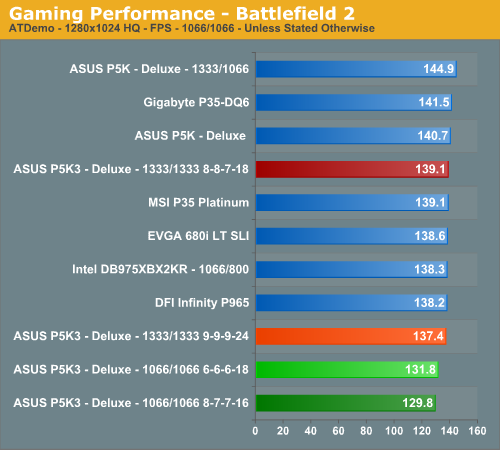
Serious Sam 2
This benchmark is performed using Croteam's built-in demo capability in the Serious Sam II engine. We utilize the included Branchester Demo and capture the playback results using the Ctrl-~ function. The benchmark features a large number of combatants, explosions, and general mayhem. The benchmark is can be CPU bandwidth or GPU sensitive depending upon the settings and resolution. We typically find this game is very playable at average in-game rates of 55 and above. We maximize all settings except antialiasing and anisotropic filtering within the general and advanced video settings.
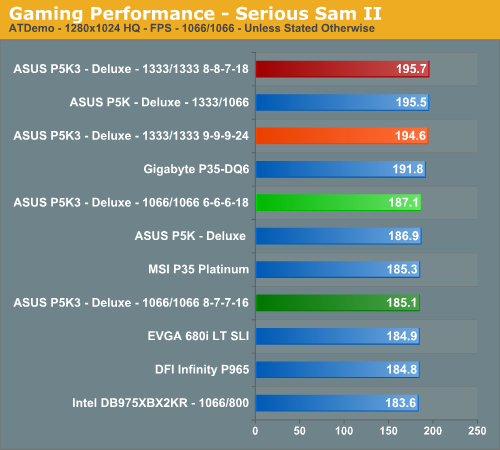
F.E.A.R.
F.E.A.R. uses a built-in performance test that generates graphical test scenes based upon the actual game engine. This test consists of a couple of different action sequences, a stressful water flyby, and heavy use of shadows while traveling through hallways. F.E.A.R. is a very graphics intensive game and we switch all settings to maximum for both the system and GPU except we disable "soft shadows". We find the game is playable around 35fps although we prefer a solid 45fps.
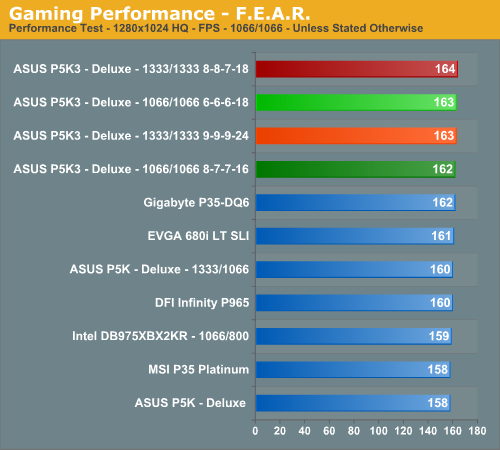
Gaming Summary
We see the DDR3 setups struggling in the Battlefield 2 tests even with improved latencies which only account for around a 1% improvement in the scores. The high latencies and relaxed memory sub-timings of our DDR3 systems are still suited for this game. In the CPU/GPU bandwidth hungry F.E.A.R., the DDR3 platforms have a slight advantage with the improved memory timings showing an improvement, albeit a minor one. Our Serious Sam 2 benchmark at this resolution is both CPU throughput and memory bandwidth sensitive to some degree. The increased bandwidth offered by the 1333FSB setting allows this configuration setting to provide the best scores. Once again, we see very minor improvements with the lower DDR3 memory timings mainly due to relaxed sub timings.
Supreme Commander
Supreme Commander is one of the better RTS games to be released in recent memory although we are still huge fans of Command and Conquer 3 along with Company of Heroes. We chose Supreme Commander as it is both a GPU and CPU hog when it comes to systems resources. We utilize the built-in performance test to benchmark the game. We set all of the settings to high and only change the resolutions or AA settings between benchmark runs. This benchmark provides a cornucopia of results but for our tests we will report the average frame rates during the benchmark. We generally find this game to be playable across the network with frame rates at or above 30fps.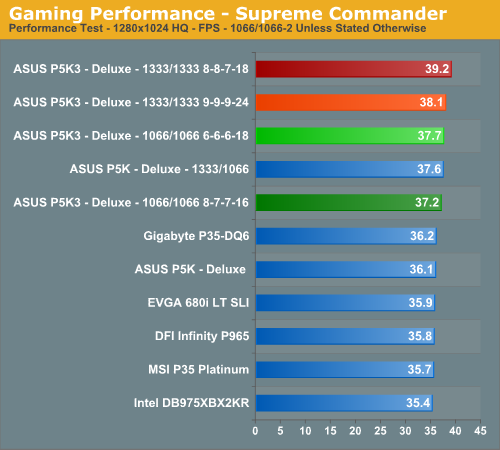
Company of Heroes
Company of Heroes was released last year and is still proving to be a very addictive RTS game around the office. The game is extremely GPU intensive and also requires a hefty CPU at times. The game contains a built-in performance test that utilizes the game engine to generate several different action scenes. We found the performance test gives a good indication of how well your system will perform throughout the game on average. We have found some of the in-game action sequences to be more demanding than the performance test and are working on game play benchmark that is repeatable. We generally found the game to be enjoyable with an average frame rate above 35fps.
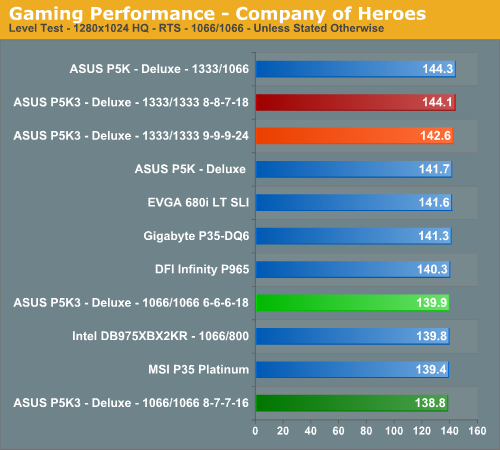
Prey
Prey offers some superb action sequences, unique weapons and characters, and is a visually stunning game at times. It still requires a very good GPU to run it with all of the eye candy turned on. We set all graphic settings to their maximum except for AA/AF and utilize a custom timedemo that takes place during one of the more action oriented sequences. We generally found the game to be enjoyable with an average frame rate above 35fps.
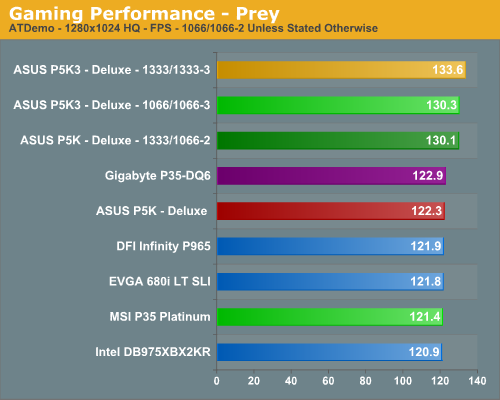
S.T.A.L.K.E.R.
S.T.A.L.K.E.R. is one of the favorite first person shooter games around the office as it continues to provide a great deal of replay value and the graphics are very good once the eye candy is turned on. What we especially like about the game is the atmosphere and the fact that it makes for a great system benchmark.
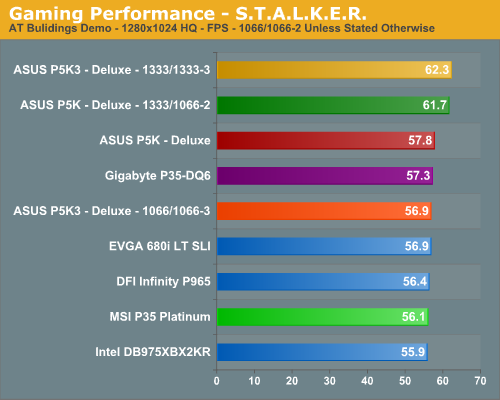
Gaming Summary
We were not expecting significant improvements in Supreme Commander as the game will take any system you throw at it and send it flying back to you at maximum settings. The one positive is improved memory timings at DDR3-1333 resulted in an almost 3% performance improvement. In Company of Heroes and Prey we see the familiar 1% improvement when lowering the memory timings. The most significant improvement in our game testing is in S.T.A.L.K.E.R. with the DDR3-1066 setup showing an 11% improvement when lowering the memory timings indicating this game is very sensitive to both bandwidth and latencies. We tripled checked out setup and scores, each time we had the same results.
High Resolution Gaming
We ran our benchmarks at a 1920x1200 resolution with 4x antialiasing and with 8x anisotropic filtering (if the game has support) enabled. We feel this resolution will be the best indicator of performance for users with a high-end CrossFire and CPU setup. Our performance update is based on how well R600 CrossFire works on the ASUS P5K3-Deluxe DDR3 motherboard with the current 8.37.4.3 drivers. The ASUS P5K-Deluxe board utilizes DDR2 memory as does the Intel 975X system.
We have completed testing with the latest beta ATI drivers and have seen improvements in several games by a couple of percent. However, the driver still does not work well under Vista with CrossFire enabled in OpenGL based games so we are withholding our results until the official drivers launch at the end of the month. Contrary to early reports across various forums we have not seen 20%~30% improvement in scores. Various 3DMark scores have improved up to 9% in cases but current game scores are showing improvements of 2% on average.
Company of Heroes
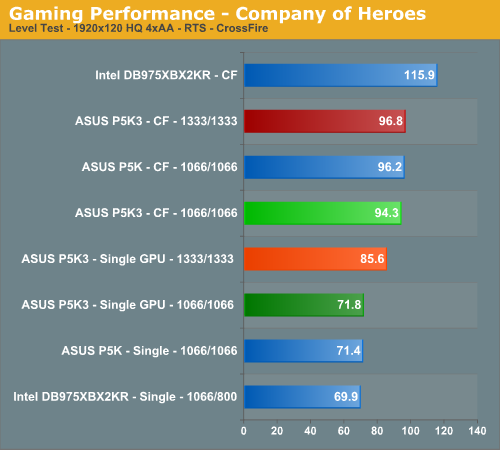
Prey
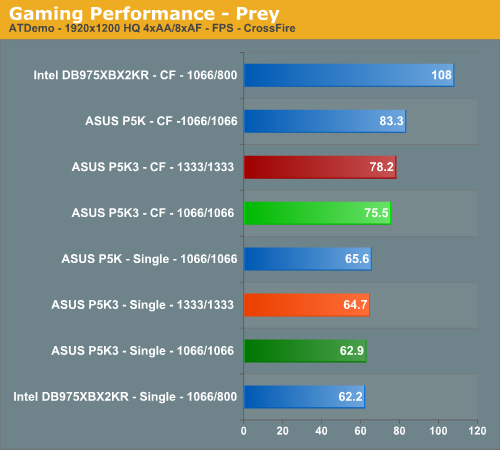
S.T.A.L.K.E.R.
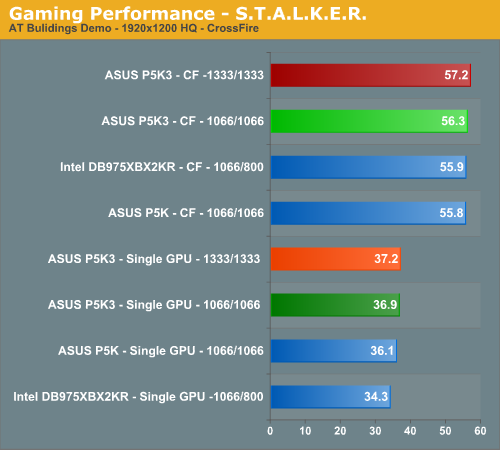
The P35 boards do very well in single card configurations at these higher detail settings and follow the same performance pattern we noticed in the 1280x1024 testing. The S.T.A.L.K.E.R. results surprised us as this was the only game where the P35 boards scored better than the 975X in CrossFire. Prey and Company of Heroes still show relatively poor CrossFire 2900 XT performance on the P35 chipset regardless of memory choice. This is an area that both the BIOS programmers and AMD are working to address, and we expect the next official Catalyst driver release to improve results on the P35 platforms. This is just another indication that the drivers and BIOS are still a work in progress, particularly in multi-GPU setups.
Synthetic Graphics Performance
The 3DMark series of benchmarks developed and provided by Futuremark are among the most widely used tools for benchmark reporting and comparisons. Although the benchmarks are very useful for providing apples-to-apples comparisons across a broad array of GPU and CPU configurations they are not a substitute for actual application and gaming benchmarks. In this sense we consider the 3DMark benchmarks to be purely synthetic in nature but still very valuable for providing consistent measurements of performance.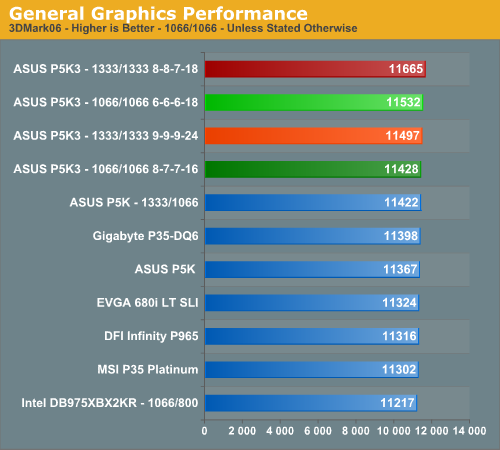
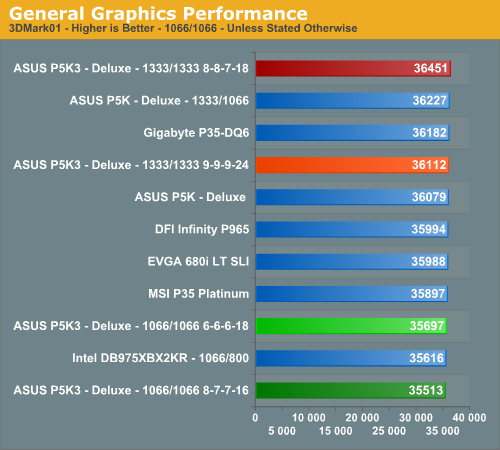
The updated BIOS and memory timings improve the DDR3 scores slightly in both Futuremark benchmarks, but the scores are still tightly clustered. Particularly in 3DMark06, the GPU is generally the bottleneck except for the SM3.0 tests, but we do see minor improvements with the 8-8-7 DDR3-1333 and 6-6-6 DDR3-1066 settings regardless.
Quick Take
There are no real surprises in our memory testing today except for the 11% improvement in the S.T.A.L.K.E.R. DDR3-1066 score with 6-6-6-18 timings. Overall, the performance improvements of moving to lower memory timings were around 1%~2% on average. Not bad, considering our memory sub-timings had to be significantly relaxed in some cases to run at the lower timings on stock voltages. We were hoping for more but it is obvious after running some initial benchmarks that we need to spend more time tweaking and tuning the 0411 BIOS that ASUS provided today. Besides offering 1T command rates, this BIOS will allow up to DDR3-2200 speeds if you have memory that will do it. Expect to hear more from us shortly on this BIOS release and additional ones received from Gigabyte and MSI.We are still trying to find the right balance of settings/voltages with our Corsair DDR3 modules on two other DDR3 motherboards. We thought we had stumbled upon the right mix of speed, latencies, and timings yesterday, but with BIOS of the day releases from the manufacturers at this point, it is difficult to setup a board properly without having the next BIOS appearing in your mailbox. We are not complaining, far from it, considering the dearth of BIOS releases during the initial P965 launch activities. We are greatly pleased with the manufacturers at this point in their ability to address problems and improve performance on an almost daily basis.
Unfortunately, we do not have new video card drivers so our results today mirror those of our P35 CrossFire preview article last week. The performance differences between our DDR2 and DDR3 boards mirrored our single GPU results. While the P35 was not designed specifically with CrossFire in mind, it does possess this capability. As such, we are still hoping that AMD can tune their R600 drivers properly in a reasonable amount of time to improve CrossFire performance on the Intel chipsets.
Considering the performance of the P35 chipset when set up correctly, we would love to see a manufacturer utilize a different PCIe controller chip setup and bring 8x8 CrossFire capability to this chipset. If abit or DFI is listening, please take a run at it as this type of engineering is something you excelled at previously. If not, we anxiously await the new X38 chipset even though the 975X obviously still has a lot of life left in it.
Overall, we still have a lot P35 motherboard testing left to complete and then we'll be reporting the results to you. We've only scratched the surface when it comes to overclocking and improving memory performance on our boards. Of course this is only one area of interest and we also have some significant storage subsystem testing to complete on the new ICH9 along with revised network/audio benchmarks for Vista. With Barcelona/Agena on the horizon, this is shaping up to be one very busy and exciting summer.







